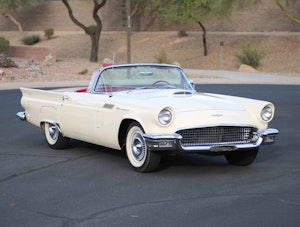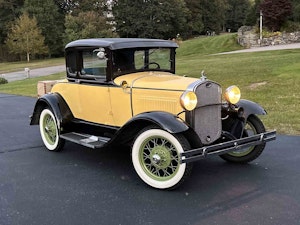Media | Articles
Scout EV Forum: Prospective Buyers Give Thumbs Down to All-Electric Model
Hey, fans of the new Scout! Are you ready for an all-electric SUV and pickup?
Well, apparently not. A crowd-sourced list compiled by the Scout EV Forum, based on reservations made by 600 prospective buyers of the new Scout, reveals that fewer than 20 percent of customers are opting for the electric-only model, with the rest specifying models with range-extender gasoline engines.
Here are the stats from the Scout EV Forum:
Full electric or Range Extender:
Electric + Gas (Harvester): 81.3 percent
Full-Electric Only: 18.7 percent
SUV or pickup:
Traveler SUV: 58.2 percent
Terra Pickup: 34.2 percent
Both: 7.7 percent
Previously/currently own an EV:
Yes: 47.1 percent
No: 52.9 percent

Scout hasn’t said how much the range extender will cost. Claims the order page for the Traveler SUV at ScoutMotors.com: “Entry models starting as low as $50,000 with available incentives. Retail prices starting under $60,000. Initial production targeted for 2027.” Same for the Terra, but the entry model is $51,500.
Marketplace
Buy and sell classics with confidence
As for the electric vs. range extender models: “Pure electric models offer up to 350 miles of range. Scout’s extended range models offer 500 miles of range or more through a built-in, gas-powered generator. Even in the middle of nowhere, you can still get there.”

Forum member TheShark posted this: “When I saw the Traveler Harvester with the extended range that convinced me to reserve.”
Scout stores will debut in 16 metro locations, and the manufacturer plans for 100 Scout stores around the country. In the order process, you click either the “Electric” or “Electric+Gas” buttons. A $100 deposit is required to hold your place in line. Clicking the second button means you are buying an Extended Range Electric Vehicle, or EREV. Electric motors will still power the vehicle, but the gas-powered generator will send juice to the batteries, not directly to the wheels. That’s why it’s incorrect to call an EREV a hybrid.

Scout hasn’t provided details on the range extender engine, but it will likely be produced by the company’s corporate owner, Volkswagen, and possibly be of three-cylinder design. Range extenders aren’t new—there are plenty of Chevrolet Volts running around with range-extender motors, long after they were introduced in 2010; and several EREVs are coming in the future, including the Ram Ramcharger, which uses the 3.6-liter V-6 to power the batteries. Driving range for the 2025 Ramcharger is projected to be 690 miles.
Anyway, the range extender is resonating with Scout prospectives. It’s a smart move on Scout’s part, and you can be sure that these statistics are the talk of every auto manufacturer today.

















Perhaps GM should bring the Volt back into production as it left (not a new model) with the improved battery tech/management now available. If many others are copying what you did… maybe you shouldn’t have stopped doing it.
Agree. I was actually considering a Volt when they announced the discontinuing of them.
Nah. It’s in their nature to cancel models when they’re just gaining traction. Fiero and Bolt come to mind.
Better include the GM EV1 with that list.
Never saw value in hybrids.
They cost more. You still have all the ICE service and expensive EV service.
Resale is not great if it needs work.
I have driven a number of Volts, Bolts Teslas and even a prototype type GM hydrogen. I like them but they make little financial sense yet.
There is no expensive EV service. The only service required for the EV side of a hybrid is to change the coolant in the separate motor/electronics cooling system. The service for the ICE part is less than a stand alone ICE vehicle since the engine runs much less often, which means longer service intervals. The regen braking also means longer brake component life.
There is a reason that the Prius is the most common Taxi/ride share vehicle and that is because of its low TCO, legendary reliability and durability. The primary reason for those attributes is the Hybrid system.
Precisely. With about 90k miles on it, my wife’s 2020 Lexus RX450h has been very low maintenance. The electric part of it has been ZERO maintenance. Great vehicle and she plans on trading for a new one in the next year.
Expensive EV service??? That is a first for me. My wife drives a RAV4 hybrid and there has been exactly ZERO EV service needed. I can’t imagine what that even means.
As for the Scout put a V8 in it and try to compete with Rover. That would make money at low volume. Park an Audi under it.
I agree, if it isnt burning fuel, I dont want it. I had a 1961 Scout 4cyl, 3 speed and it was crude but effective
I know I’m too old. Rover, not the Land Rover, was a British car manufacturer of sedans, two which were powered by a Buick V-8 used in the early ’60’s Buick Skylark line. If I’m lying, then sue me.
The range extender seems like an ideal use-case for a fuel cell. Doesn’t need to output very high peak power levels as it’s not going to drive the wheels, just recharge the battery, slowly over time. Something like a 3-5kW output fuel cell would be reasonably small and quite efficient, likely more efficient than a normal gas engine.
The ICE generator will drive the wheels electrically. It is not physically possible to simultaneously charge and discharge a battery. If the vehicle is in motion and the generator is running, that generator will be powering the traction motors. Yes there will be times when the generator is powering the vehicle and charging the battery, times where the generator gets an assist from the battery to power the traction motors and even times when the vehicle is stopping or stopped and the generator is only charging the battery. But if the vehicle is in motion and the generator is running at least some of the power will be driving the wheels w/o a trip to the battery.
The Volt is not a EREV, it is a PHEV. Yes GM claimed that it was going to be an EREV when introduced but the reality is they found pure series hybrid operation isn’t as efficient as driving the wheels mechanically. When Honda did their CA compliance PHEV Accord the findings were the same using an engine to run a generator and power the traction motor wasn’t as efficient as powering the wheels mechanically. The only EREV we have had in the US until this point was the BMW i3 REX which is terribly inefficient at gas powered operation because of all those losses turning power from the engine into AC, rectifying it into DC, transmitting it to the traction motor’s inverter, converting it back to AC power to drive the traction motor.
Thank you! That needed to be pointed out.
Not sure I get this whole new “Scout” thing, other than VW deciding it has no off-road cred itself, so let’s buy the rights to the Scout brand and, bingo, we’re in the money! I mean, how much nostalgia is there, really, for old IH Scouts to begin with? I know a few guys who are into them, but seems a pretty niche market to me. I don’t see how that translates into significant market volume potential for an all-EV new fake Scout, which has next to nothing in common with an original Scout. All hype at this point.
They didn’t buy the rights to the Scout name, they bought Navistar and those trademarks were just part of the deal and certainly weren’t the reason they purchased Navistar.
Kind of what I always thought they should do. Small ICE just to charge batteries only And extend range. When you stop to eat it could be running charging batteries or when you’re driving and batteries drop below a certain level it kicks in. Makes a lot more sense to me
I’ll let others beta test the new VW software on these things. I’m sure it’s totally bug free.
Psychology says…cars are more fun when ALL the senses are activated. No sound, no Soul.
To be fair, there is noise. It’s just not noise that *you* like. And that’s okay.
Who in their right mind would opt for an all-electric Scout?
Probably a person who likes the look of one and has usage that is appropriate for an EV. I know it’s difficult for some to believe, but those people do exist.
Evolution. I’ve been driving EVs since 2015. But because I have an antique Mercedes insured by Hagerty I’ve been a subscriber to these emails from Hagerty for much longer. It has been interesting to see the evolution in the comments section from near universal distain for EVs then to today when the anti-EV folks are still here but their numbers have decreased in relation to those of us on the other side. There will always be ICE vehicles but it’s pretty clear which way the market is going. Keep up the good discussions!
The market for EVs has softened significantly as of late, I’m not sure which way the market is going. I do know which way the mandates are going though. Not a fan of someone else deciding on my purchases.
EV’s are great for certain situations. I live in Newfoundland for us anyone living outside of the city are limited to the charging stations, and most times they are further apart then the milage you get from your battery. And when you do get there most times you are waiting up to a hour to get your turn to charge your auto. The other issue for me is the trade in value. The age of the car is no based on what is left on the life of the battery. My wife works at a dealership and as witnessed this already. People getting offered less then what they expected for a ev trade in compared to a ice. I do like the idea of the generator to extend your mileage, again for us here on the island it would make it more convenient to travel across the island. The other issue is people who say they are buying a ev to help the environment. For what it takes to make a ev it does more damage then good. I think if they put more r&d into making ice more efficient pollution wise they would be in the money.
How about a model with a straight 6 turbo diesel and no EV. That would be the best seller.
“Scout stores will debut in 16 metro locations,”
That’s about as anti-Scout as you get right there…
It’s usually a lot easier to get someone on the trail to give you five gallons of gas than it is to give you five kilowat-hours. A gas backup makes sense if you’re heading for the sticks.